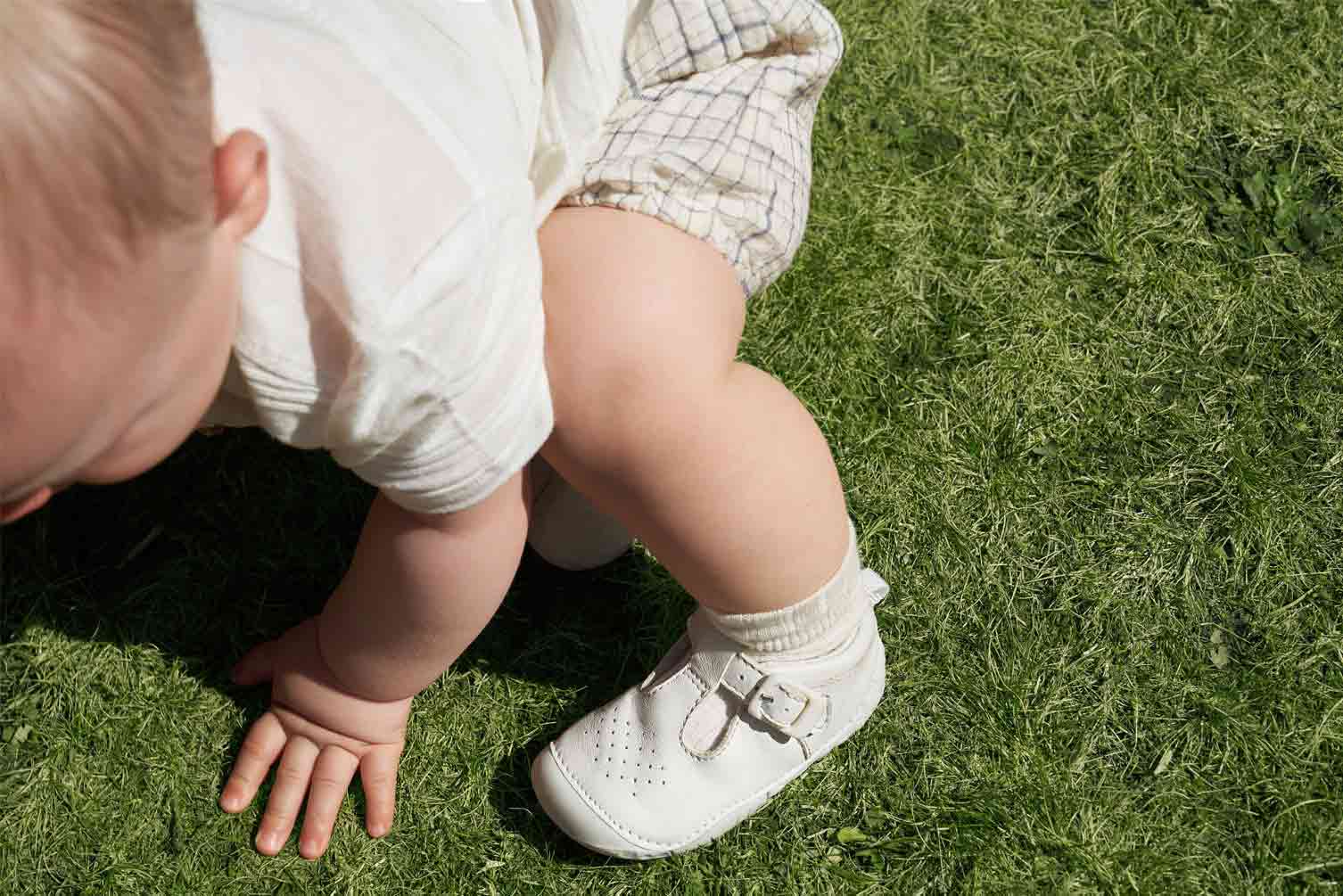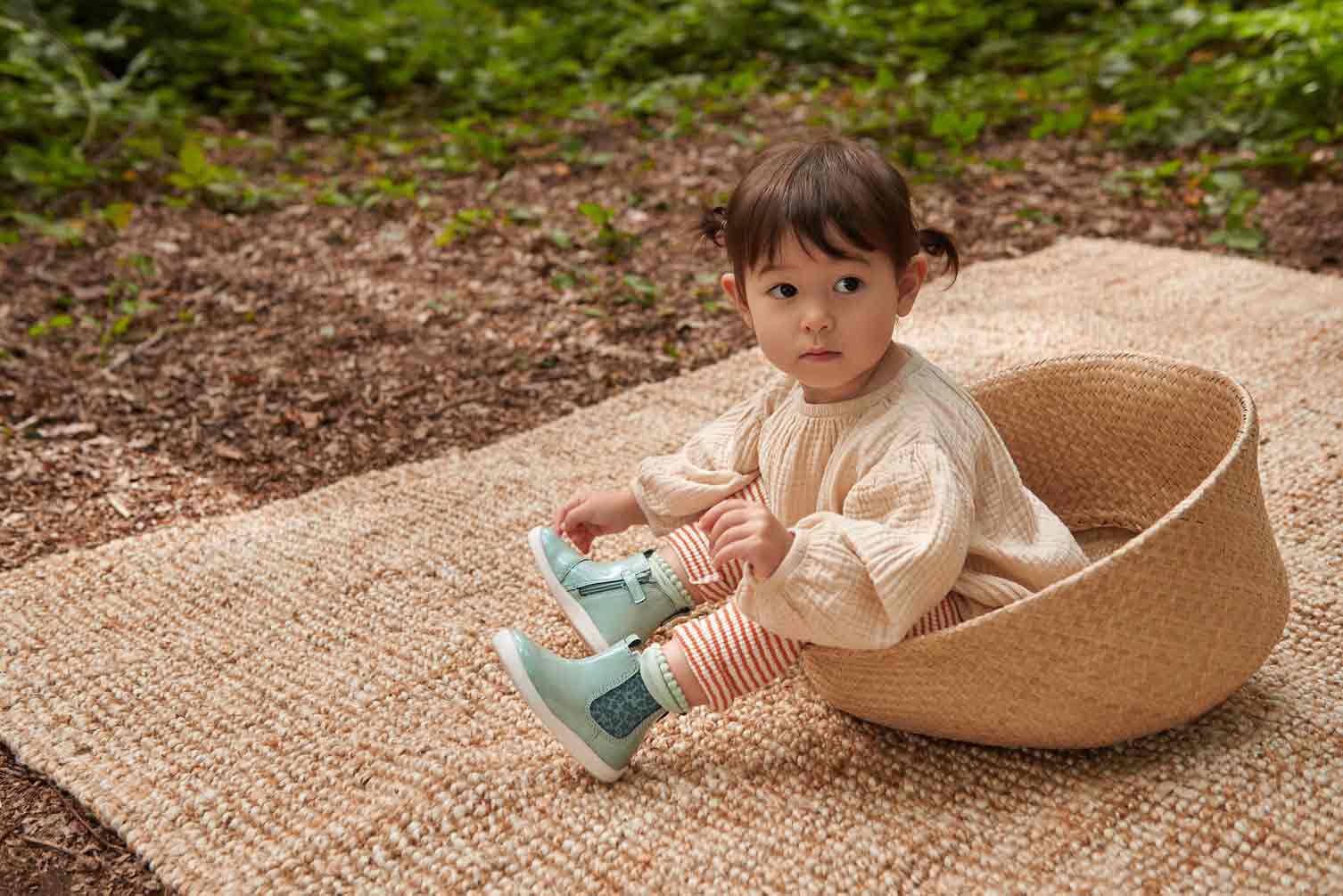
We often get asked when the right time is to buy your little one's first walking shoes. We’ve put together a Q&A that we hope answers some all-important questions.
As your baby develops, their bones are going through ossification, but ligaments still haven't fully formed, so feet are still soft and vulnerable. Your baby will start to walk when they are personally ready, and that time is determined by when the feet, legs and spine are all strong enough to start bearing weight. This is instinctive for each child and occurs at different times.
Don’t panic if other babies are walking and yours is not! It’s important that babies pass through each developmental stage before embarking on the next and they will do this in their own time. There is no rule on how quickly a baby should pass through their developmental stage and certainly no awards for racing through them before anyone else! Try to enjoy each stage as it comes. If your baby is pulling themselves up and taking their first tentative steps inside the house on internal flooring, then there is still no need for shoes.
The best time to look for shoes is when your baby starts to explore the outdoors on two feet. That is the correct time to look for more protection. Until then, barefoot is best for healthy development. Baby feet are made up of mainly soft tissue and cartilage which means they are incredibly soft and flexible. In the early stages of development, they are not designed to take any pressure from standing, and pressure from shoes or even tight socks may deform the foot during development. A baby’s feet grow naturally and develop to their best potential if left well alone. Until your baby is crawling there is no need to protect their silky soft feet. We do understand in some situations your baby’s feet may need protection, so look for crib or pram shoes that are made from super soft material.
When your little one starts their crawling journey, look for shoes with highly supple materials that offer gentle protection and maximum flexibility for this early exploration. Take a look at our baby shoes.

In 2021 we undertook research with 500 UK parents which revealed only half (57%) of parents with toddlers are confident they know the size of their children’s feet, 61% of parents with toddlers had found their children were wearing the wrong size shoes and over half (53%) had felt guilty to find their toddler’s shoes had rubbed their feet sore.
1. SHAPE: Shoes that are designed specifically for the shape of a child’s foot. It is very important that children do not wear styles created for adult feet, reduced to a child’s size.
2. GROWING ROOM: Rounded toe with added growing room to allow for growth of developing muscles, ligaments and bones.
3. PRECISION FIT: Whole and half sizes and multi-width fittings to ensure the best possible fit.
4. BREATHABILITY: Breathable linings for maximum comfort, allowing perspiration to escape through the surface of the shoe.
5. SECURITY: Secure rip-tape fasteners to give toddlers control and peace of mind they are not curling their toes to keep their shoes on.
6. SOFTNESS: High grade leather for extra durability.
7. SUPPORT: Padded ankle support and cushioned insoles with outsoles designed to be supple, flexible and allow the foot to form naturally to help with stability at this early stage of gait development.
8. LIGHTWEIGHT: Lightweight and flexible soles to allow natural easy movement to gain the right level of feedback from the terrain beneath their feet so the foot can perform naturally as an important influencer in overall physical development.
9. BUMP-PROOF: Scuff-proof heel and tow bumpers without adding weight or bulk.
The right shoes for your little one depends on what stage of movement they have reached, as different ways of getting about lead to different needs in terms of support and protection.
While you’re waiting for your baby to get to grips with crawling, they don’t typically need shoes. This is because their feet should rarely contact anything that might hurt them, as a result of the fact they don’t really use them yet. At this stage, there are only two reasons why you might choose to put some shoes on your little one: to make them look adorable, and to keep their toes warm in colder weather.
Whatever the reason, stick to pram shoes that are made for this very purpose.
Once your baby is crawling, you can often find they manage a surprising distance in a short time - even if you only turn your back for a second! On indoor surfaces, they should still be fine to go barefoot, so long as you keep the floor clear of any hazards. You may still want to use shoes if you have non-carpeted floors, though, as these can get chilly in the colder months.
If your little one starts crawling on other surfaces - for example, if you’ve taken them out onto the lawn or to the beach - then soft-soled shoes can help to keep their feet protected and supported while they explore this new landscape.
Cruising is a sort of halfway stage between crawling and walking where your little one hoists themselves up onto their feet using anything within reach - including family pets - and uses these handholds to help them begin to walk. At this point in your child’s development, their feet are getting a first taste for how it feels to walk, and they’re learning how to flex and move their feet in order to get about effectively.
For this reason, it’s important not to have them wear shoes that are too rigid, particularly in the sole areas. A thinner, flexible sole allows your baby to better feel the ground underneath them, improving their sensory connections and mobility.
They’ve done it! Now that your little one has started to walk unaided, they’ll be at it all the time - but it’s important to remember that they’re hardly an expert at this stage. They probably look really cute, with splayed feet and reaching arms as they toddle from place to place.
At this stage, it’s good to get your baby used to wearing high quality, supportive shoes with comfortable, well-gripping soles. These will help them to build good habits early on, helping to support the development of their feet through their younger years.
Shop our first walking collection >
Find out more information on buying your baby’s first pair of shoes>
Author: Stacey, published 06-05-2022.